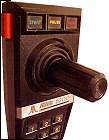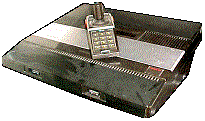 After a long development process (during which it was briefly known as “Atari Video System X”), Atari introduces its own next-generation video game console, Atari 5200. Dubbed “The Supersystem,” the new console, boasting far better graphics and sound capabilities than the VCS, is hampered by one of the worst controller concepts in video game history. Also not helping the 5200’s chances are the lack of an adapter allowing VCS owners to painlessly transition to the new system, a peripheral already available for the Colecovision. (In keeping with the new system’s name, the VCS is also now marketed as the Atari 2600.)
After a long development process (during which it was briefly known as “Atari Video System X”), Atari introduces its own next-generation video game console, Atari 5200. Dubbed “The Supersystem,” the new console, boasting far better graphics and sound capabilities than the VCS, is hampered by one of the worst controller concepts in video game history. Also not helping the 5200’s chances are the lack of an adapter allowing VCS owners to painlessly transition to the new system, a peripheral already available for the Colecovision. (In keeping with the new system’s name, the VCS is also now marketed as the Atari 2600.) ![]()
 Not long after the Atari 2600 debuted, Atari tried to extend its market dominance into the home computer market with the Atari 400 and Atari 800, home computers with, respectively, 16k and 48k of RAM, the ability to add disk drives and modems, and more. But at the heart of both machines was the same industry that had made Atari a household name to begin with – both of Atari’s computers required RF connectors to use a TV as a display, and both had cartridge slots for games.
Not long after the Atari 2600 debuted, Atari tried to extend its market dominance into the home computer market with the Atari 400 and Atari 800, home computers with, respectively, 16k and 48k of RAM, the ability to add disk drives and modems, and more. But at the heart of both machines was the same industry that had made Atari a household name to begin with – both of Atari’s computers required RF connectors to use a TV as a display, and both had cartridge slots for games.
After failing to set the young home computer market on fire – at that time, Apple and IBM had already conquered the world with the Apple IIe and the original PC – Atari took its computers’  processors, put them in a keyboard-less casing, repackaged the cartridges, and created the Atari 5200 – rather more expensive than the Atari 2600, but capable of coming much closer to emulating everyone’s favorite arcade games.
processors, put them in a keyboard-less casing, repackaged the cartridges, and created the Atari 5200 – rather more expensive than the Atari 2600, but capable of coming much closer to emulating everyone’s favorite arcade games.
It’s easy to criticize Atari for making the 5200 unit completely incompatible with the far more prolific Atari 2600 – and more to the point, incompatible with most 2600 owners’ growing collection of cartridges which would be useless with a new platform – and this made the Atari 5200 strictly a high-end luxury niche platform with a small audience. By the time they wised up and put a 2600 Adapter on the shelves, it was too late.
A Phosphor Dot Fossil examined by Earl Green
